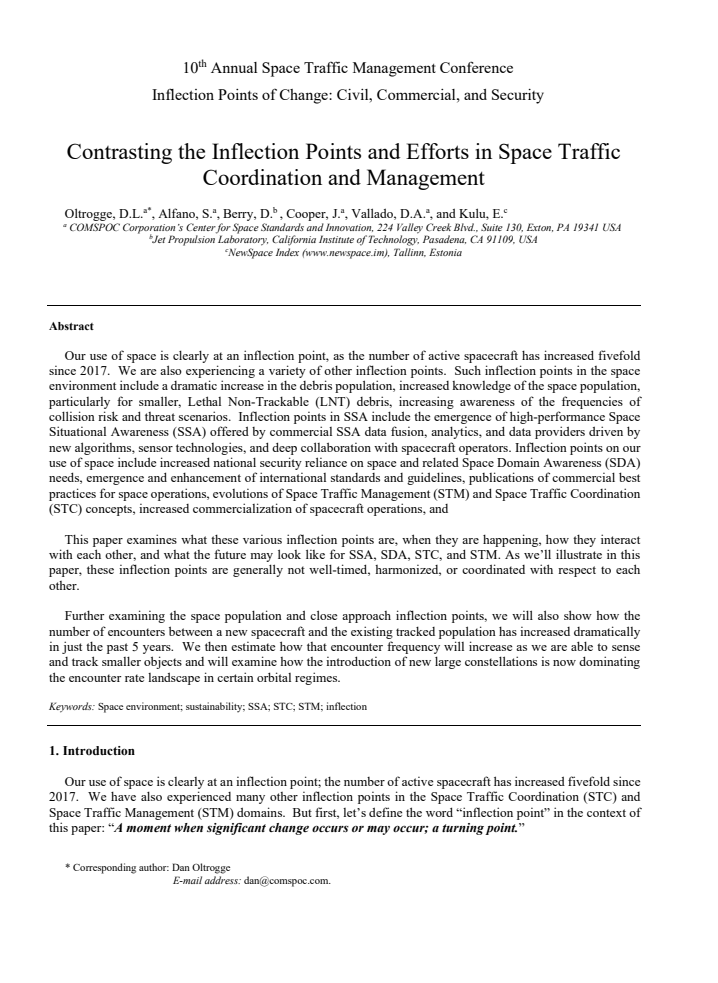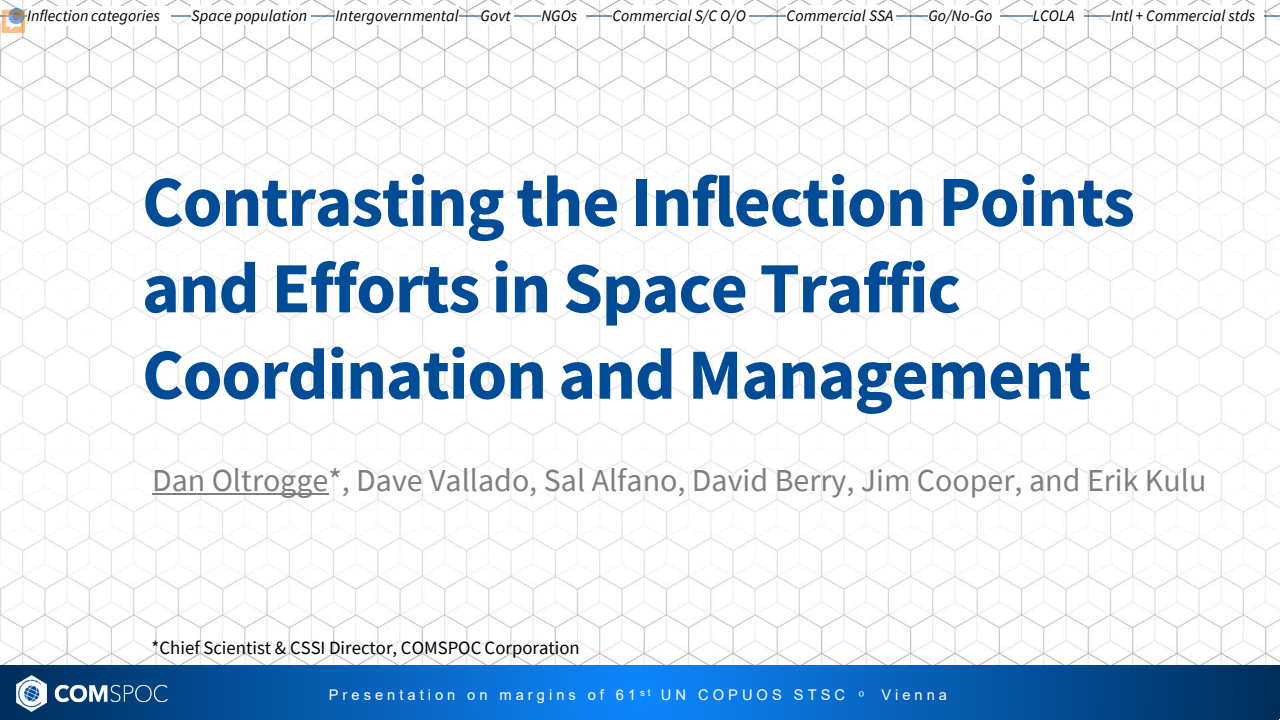Contrasting the Inflection Points and Efforts in Space Traffic Coordination and Management


Id: 360
Type: Keynote
Published: 02/27/2024
Event: IAA/UT 2024 STM Conference
Authors:
Click an author to filter the list of related assets below.Abstract:
Our use of space is clearly at an inflection point, as the number of active spacecraft has increased fivefold since 2017. We are also experiencing a variety of other inflection points. Such inflection points in the space environment include a dramatic increase in the debris population, increased knowledge of the space population, particularly for smaller, Lethal Non-Trackable (LNT) debris, increasing awareness of the frequencies of collision risk and threat scenarios. Inflection points in SSA include the emergence of high-performance Space Situational Awareness (SSA) offered by commercial SSA data fusion, analytics, and data providers driven by new algorithms, sensor technologies, and deep collaboration with spacecraft operators. Inflection points on our use of space include increased national security reliance on space and related Space Domain Awareness (SDA) needs, emergence and enhancement of international standards and guidelines, publications of commercial best practices for space operations, evolutions of Space Traffic Management (STM) and Space Traffic Coordination (STC) concepts, increased commercialization of spacecraft operations, and This paper examines what these various inflection points are, when they are happening, how they interact with each other, and what the future may look like for SSA, SDA, STC, and STM. As we’ll illustrate in this paper, these inflection points are generally not well-timed, harmonized, or coordinated with respect to each other. Further examining the space population and close approach inflection points, we will also show how the number of encounters between a new spacecraft and the existing tracked population has increased dramatically in just the past 5 years. We then estimate how that encounter frequency will increase as we are able to sense and track smaller objects and will examine how the introduction of new large constellations is now dominating the encounter rate landscape in certain orbital regimes.
Keywords:
Click a keyword to filter the list of related assets below.Citation:
Oltrogge, D.L., Alfano, S., Berry, D., Cooper, J., Vallado, D.A., and Kulu, E., “Contrasting the Inflection Points and Efforts in Space Traffic Coordination and Management,” IAA STM Conference, University of Texas at Austin, 27 February 2024.
Papers with related authors:

Assessing passive radar for LEO SSA
Read More



Using Spacebook and Cesium to Promote and Enhance Flight Safety
Read More

Actionability and Persistence Of Conjunction Data
Read More

Actionability and Persistence of Conjunction Data
Read More

Practical issues with using a full gravity field
Read More
LEO satellite behavior during the May 2024 Gannon geomagnetic storm
Read More
Deep operator and SSA collaboration for space sustainability
Read More
Synthetic Covariance Production Using a New Digital Approach
Read More
Watch out GEO satellites, here’s a new ML-method for manoeuvre detection and intent classification
Read More
Addressing the debilitating effects of maneuvers on SSA accuracy and timeliness
Read More
Actionability and Persistence of Conjunction Data
Read More
Navigating the Final Frontier: An Overview of the Space Operational Environment and the Challenges Ahead
Read More
DEEP OPERATOR AND SSA COLLABORATION FOR SPACE SUSTAINABILITY
Read More

Achieving Space Sustainability through Intense Operator and SSA Collaboration
Read More


Russian ASAT Debris Cloud Evolution and Risk
Read More

Results of comprehensive STCM data fusion experiment
Read More

Book Chapter for A Closer Look at Space Debris: “Space Situational Awareness and Space Traffic Management”
Read More
SSA degradation from large constellations: A Starlink-based case study
Read More




Debris Risk Evolution And Dispersal (DREAD) for post-fragmentation modeling
Read More
Practical considerations and a realistic framework for a Space Traffic Management system
Read More
Sequential Processing of ILRS Observations – Experiences over the last 5 years
Read More



Fragmentation event debris field evolution using 3d volumetric risk assessment
Read More

Application of New Debris Risk Evolution And Dissipation (DREAD) Tool to Characterize Post-Fragmentation Risk
Read More
Orbital Strategies to Mitigate the Solar Exclusion Effect on Space-Based Observation of the Geosynchronous Belt
Read More
New Consolidated Files for Earth Orientation Parameters and Space Weather Data
Read More
Updated Analytical Partials for Covariance Transformations and Optimization
Read More
Sequential Orbit Determination Using Satellite Laser Ranging
Read More
Improved SSA through orbit determination of Two Line Element Sets
Read More


Evaluating Gooding Angles-only Orbit Determination of Space Based Space Surveillance Measurements
Read More
ORBIT DETERMINATION ISSUES AND RESULTS TO INCORPORATE OPTICAL MEASUREMENTS IN CONJUNCTION OPERATIONS
Read More




